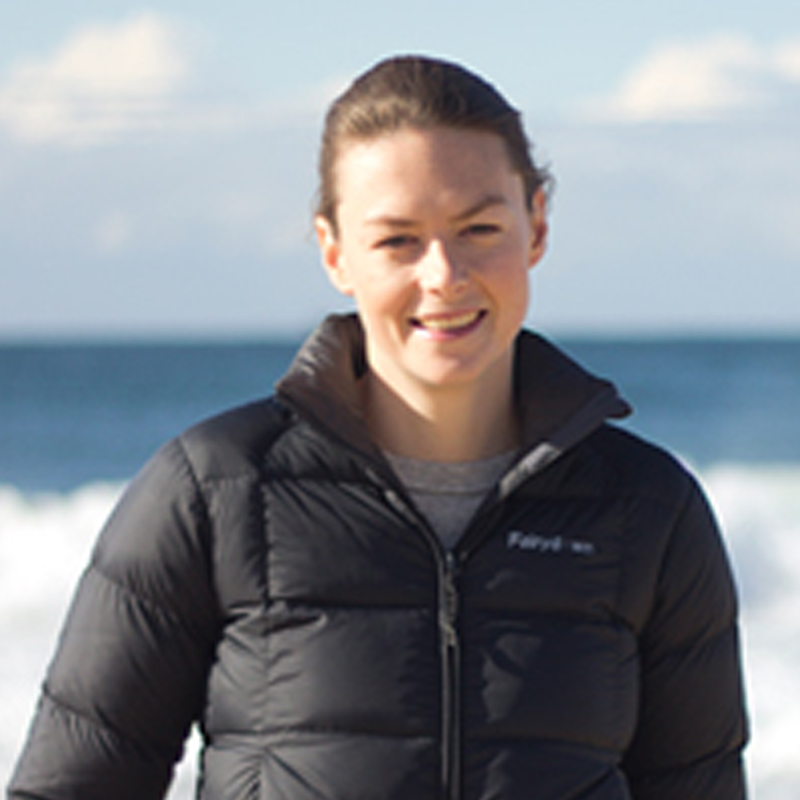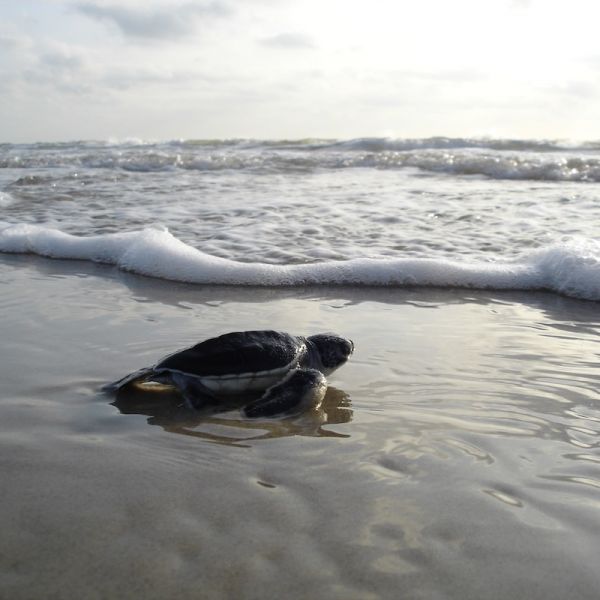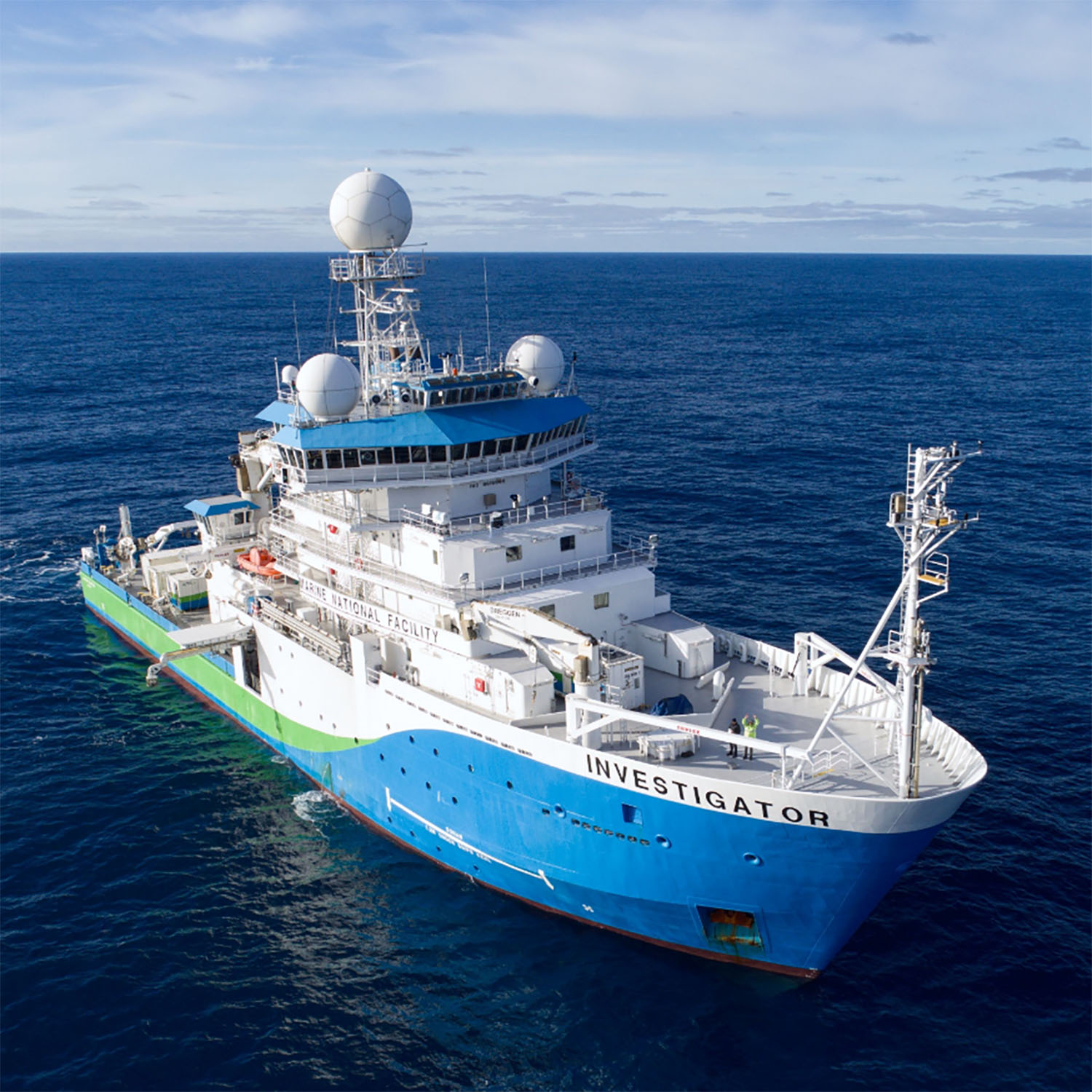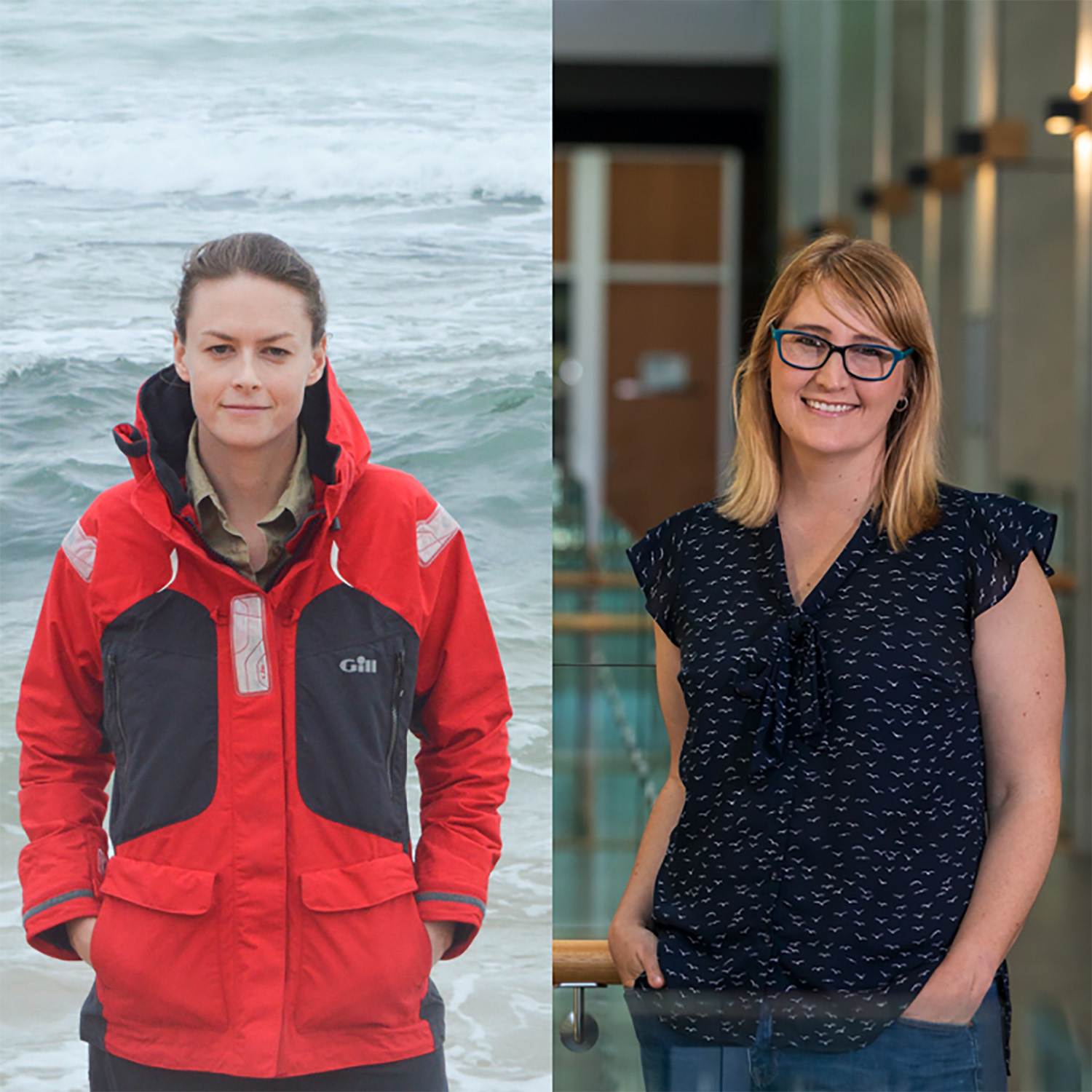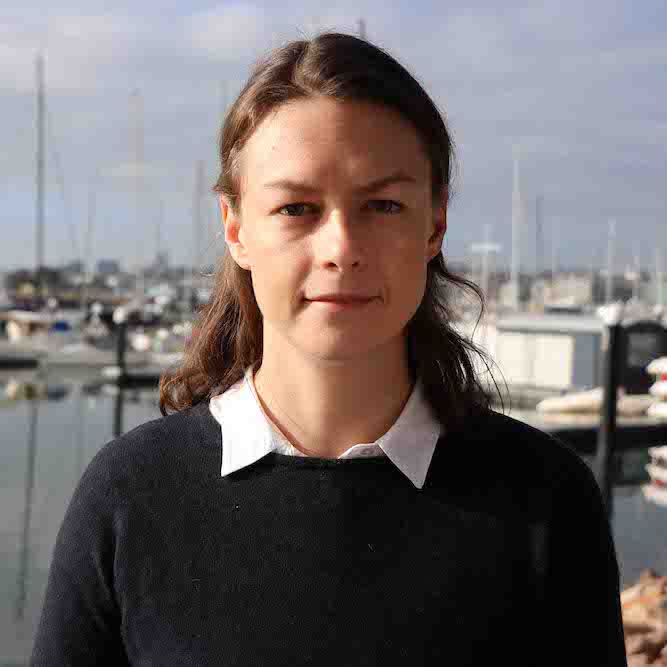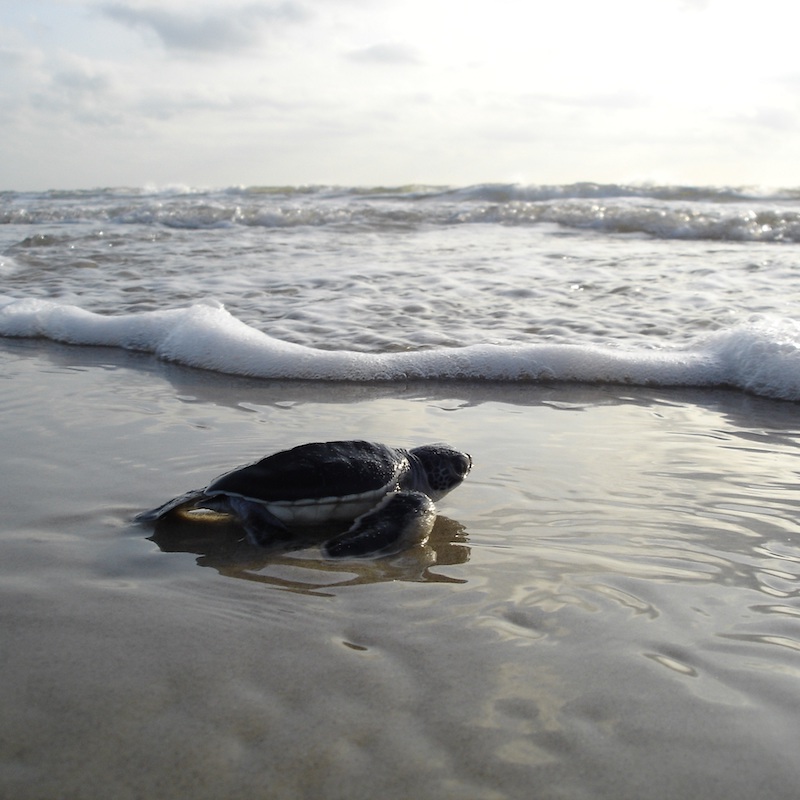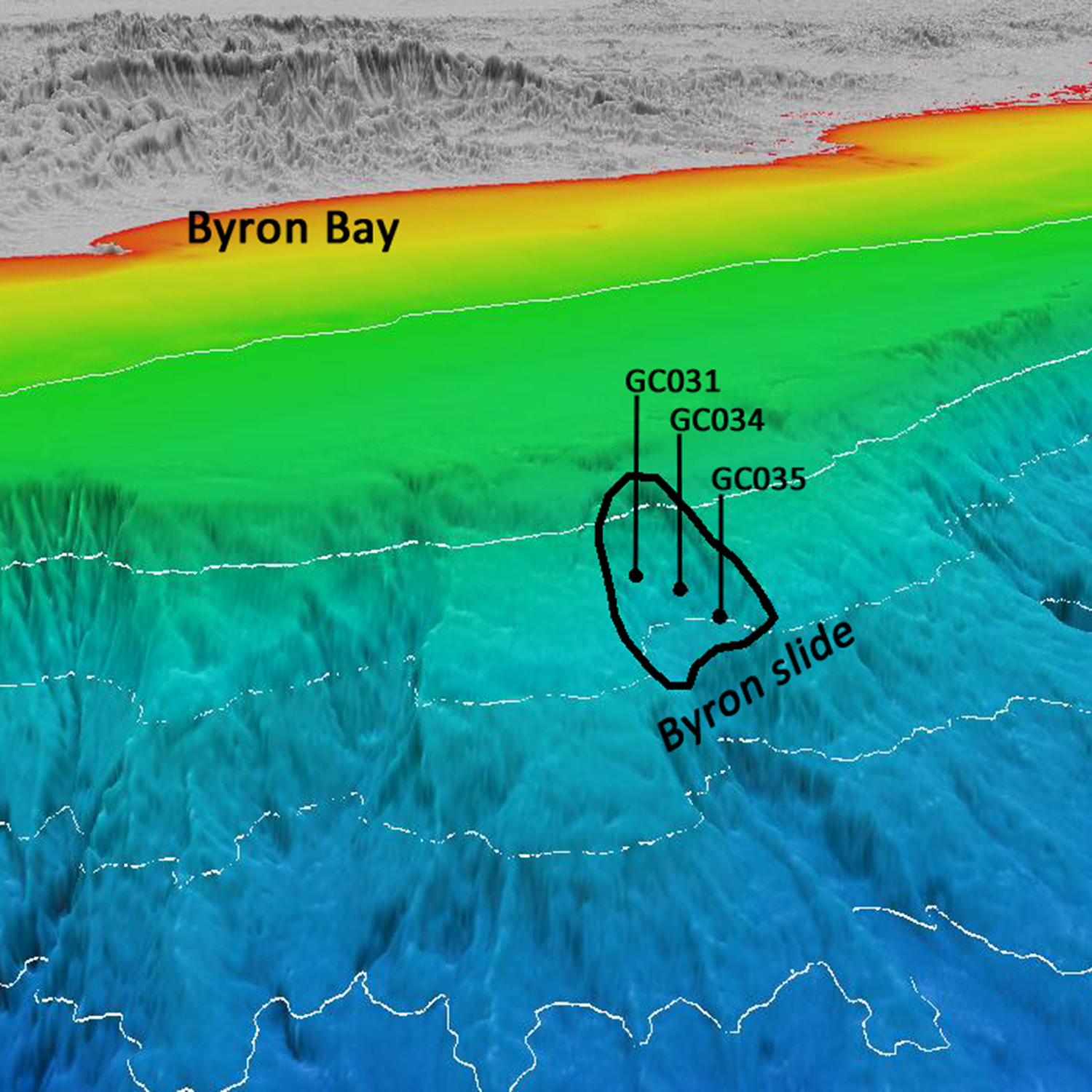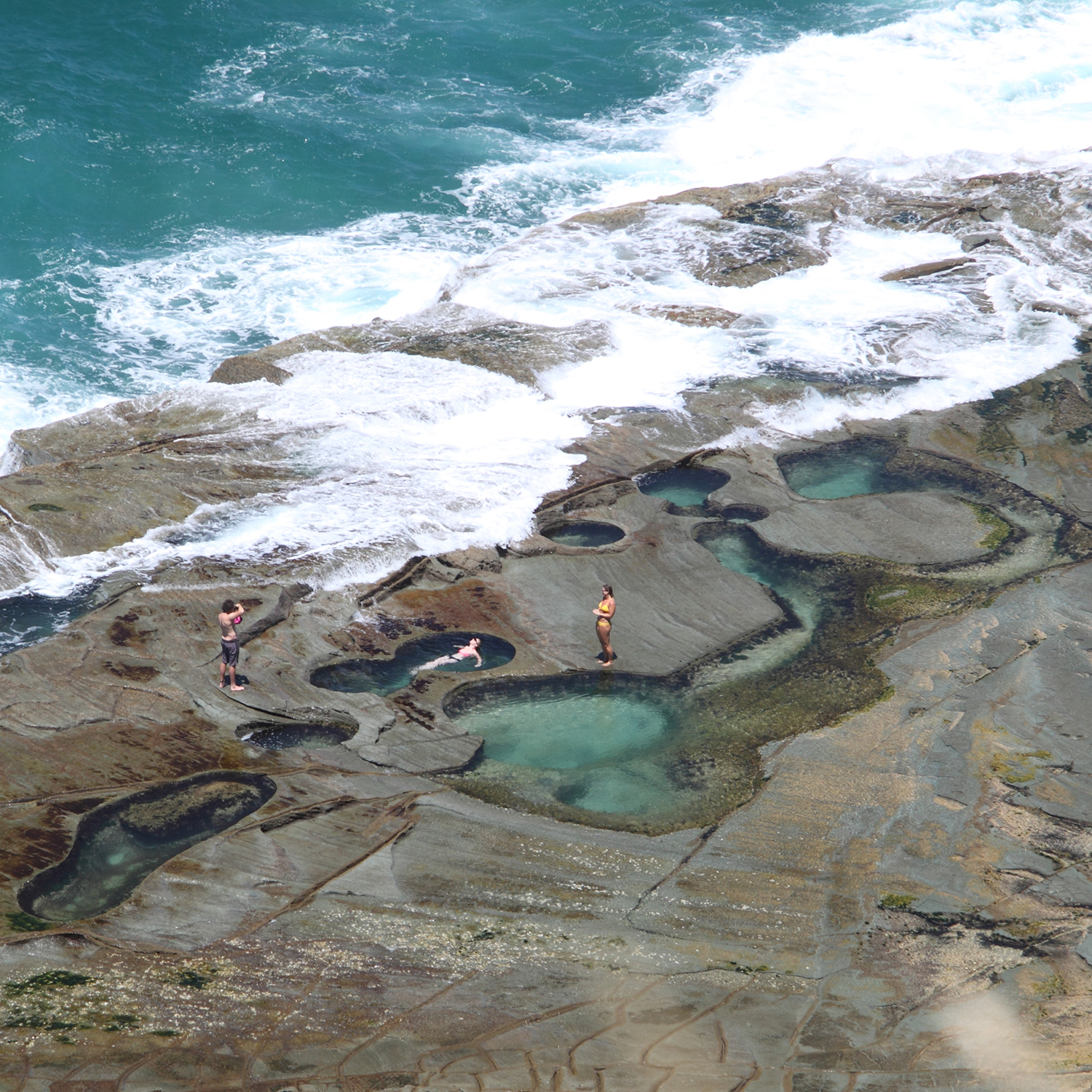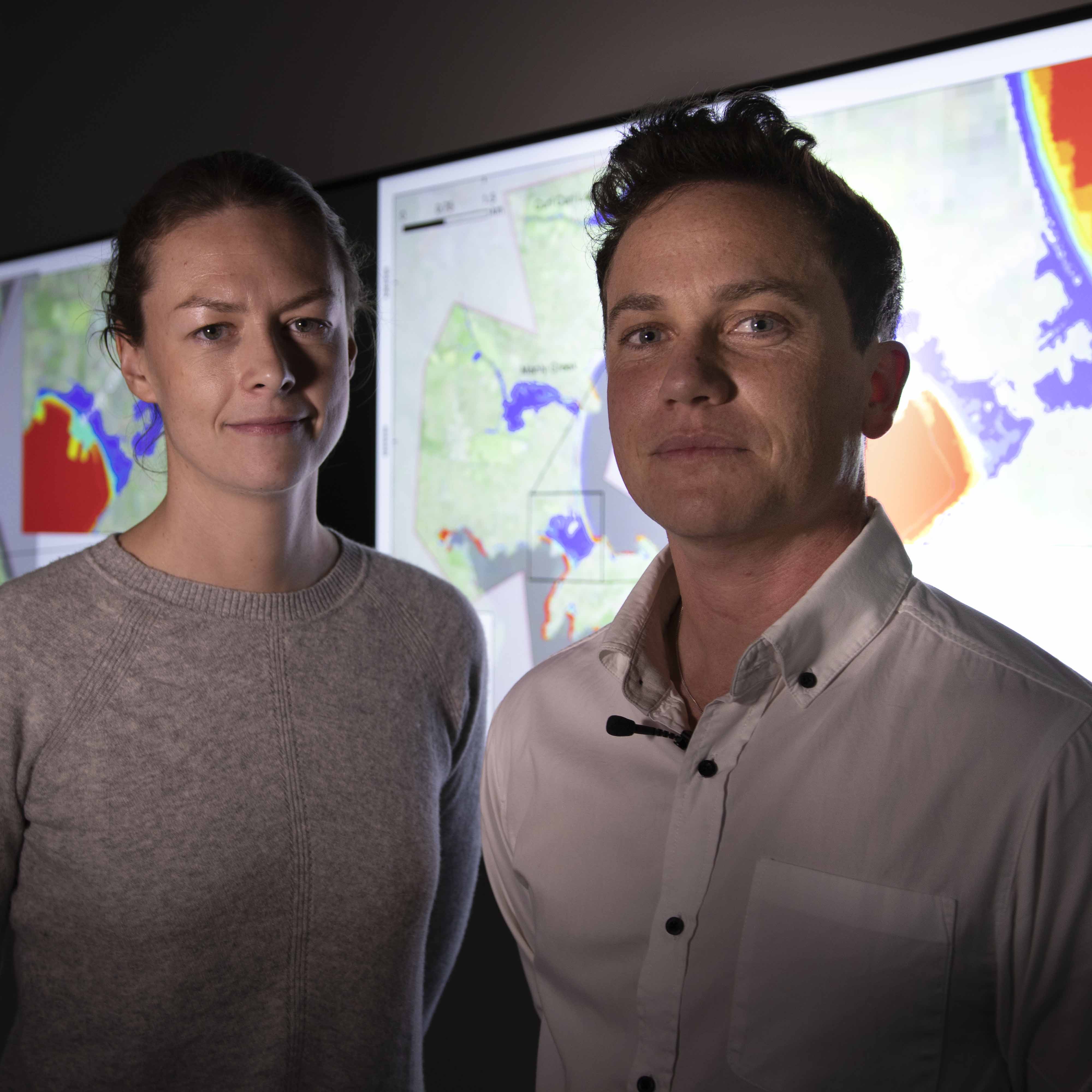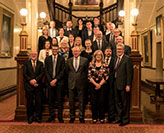
Associate Professor Hannah Power
Associate Professor
School of Environmental and Life Sciences (Earth Sciences)
- Email:hannah.power@newcastle.edu.au
- Phone:(02) 4921 5606
Shifting sands
Coastal morphologist and geologist Dr Hannah Power is translating her research by collaborating with governments and councils so they can better manage coastal environments.
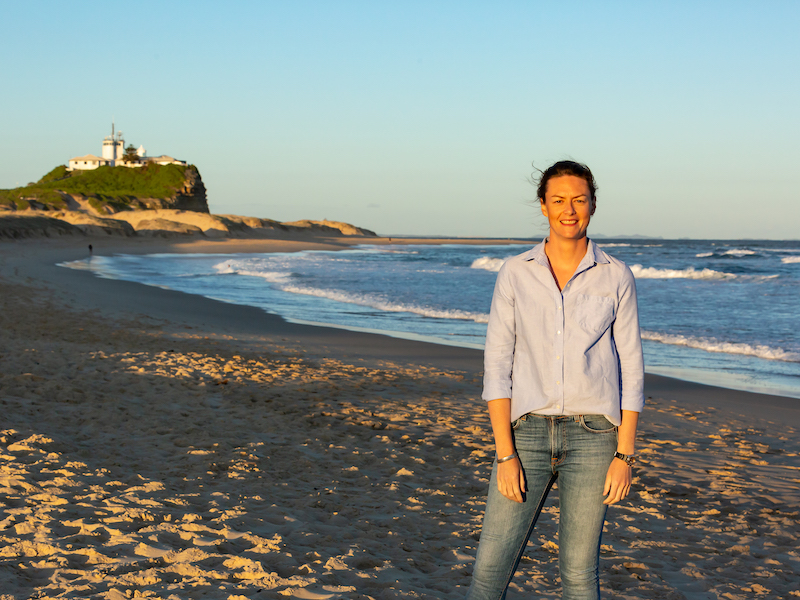
What many of us don’t realise is that our coastlines are constantly changing. So when it comes to optimal coastal management, there is no one-size-fits-all approach.
Hannah researches the processes and morphology of coastal environments by utilising field studies, remote sensing and modelling to investigate a range of diverse environments and processes such as tropical coral reefs, sandy beaches and hazards such as tsunami. This work enables us to understand the drivers that impact erosion and deliver the evidence needed for coastal risk assessment and long-term planning.
“In Australia we’ve been so lucky that we have such beautiful coastlines that we’ve been able to preserve for so long,” Hannah says. “Culturally we’re just not used to the idea of the actual beach being a highly modified environment.”
A coastal country
“We live on the fringes of this country,” Hannah says. “Around 85% of the Australian population live within 50 kilometres of the coast, and around 50% live within about 7 kilometres.” The Australian identity is closely tied to the beach and how we use it.
When it comes to coastal management, there are a lot of vested interests: residents, local councils, surfers and swimmers, state governments – and the scientists like Hannah who study coastal morphology.
‘How do we balance the desire to protect the amenities of the beach and the areas behind it?’ is just one of the challenging questions that Hannah’s work strives to answer. “The issue is cyclical: how you define the actual beach as existing depends on the timeframe. If we look at one day, it sits within the range that gets wet by the tide. But over a much longer timescale, and factoring in big storms, that blows out to a much bigger area.”
“When planning for the future, we have to think about what our beaches are going to look like in 10, 20 or 50 years,” Hannah says.
The challenge in this country is that, in places, we’ve built on what is effectively the active beach system. “That’s why we’ve had dramatic impacts in NSW like at Collaroy and Narabeen where we’ve seen pools and people’s verandas falling onto the beach,” Hannah says.
And scenes such as these are only going to become more commonplace. “Rising sea levels effectively mean we’re going to have less and less of a buffer between the ocean and the infrastructure behind it.”
Weighing up the options
Hannah is now turning her expertise to translating her research to advise governments on coastal management. In May 2020 Hannah was appointed via a competitive process to the NSW Coastal Council, where she is working alongside experts in local government, economics and local history to provide advice to the NSW Minister for Local Government on the development and implementation of coastal management programs by local councils.
“I’m looking forward to using my skills and knowledge to enhance coastal management around the state,” Hannah says. They’ve done a really good job of selecting a panel that covers off a range of expertise that’s relevant to managing the coast.”
Hannah says that the Coastal Management Act, which commenced in 2018, is a positive step forward when it comes to effectively and collaboratively managing our environment. “It really changed the way that councils and local governments were encouraged to think about how they managed their coast. It’s aiming to develop a more wholistic system where we think about how estuaries and open coast systems are connected.”
“The act encourages councils that share adjacent sections of coast to communicate with each other,” Hannah says. “For example, City of Newcastle and Port Stephens Council share a stretch of coast from Stockton up to Anna Bay and there’s a legislative boundary in the middle. But of course, the sand doesn’t stop there, so thanks to this relatively new act, the two councils are required to consult with each other around their management of that stretch of coastline.”
Managing the coast is complex. “A lot of the structures we’ve built are not very moveable,” Hannah says. “There are a range of options: do nothing, which is the cheapest option, but has long-term ramifications. Or we can build hard seawalls everywhere – but that’s quite costly and while it protects the structures and property, it can have a negative impact on the amenity of the coastal system – which is what we’re seeing at Mitchell Street in Stockton.”
“There are other options in between like ‘retreat and relocate’ – which involves picking everything up and moving it backwards,” Hannah says. “But that’s not often an option that communities are particularly amenable to because it means reshaping what the community looks like.”
Hannah notes that there are some good examples of coastal management, both in Australia and overseas. “But the problem is that coastal management is very site-specific,” Hannah says. “Solutions have to be really unique to sites because each community will have different viewpoints about what’s acceptable and what’s not. And often you’ll have different groups and opinions within each community as well.”
Solving problems with science
Hannah’s background in modelling ocean waves and how they affect the movement of sand and sediment comes to the fore in long-term planning. Her work underpins the effective management of sustainable coastal environments through predicting beach erosion and how beaches change over time. “It’s really important that we understand the environment before delivering engineering solutions to problems,” Hannah says.
“You also need to understand the economics of that situation and work with all the different groups to decide which management options are going to suit that community best. It’s a huge puzzle and there are so many pieces in it.”
One of Hannah’s recent collaborative projects was working with the NSW Department of Planning, Industry and Environment on the Figure Eight Rock Platform, a site in the Royal National Park in Sydney that went viral on social media due to unique rock pools, including one formed in the shape of a figure 8.
“There were huge issues because all these people were going there with no knowledge about what it’s like to go for a two and a half hour bushwalk to get to a site, they weren’t looking at what the conditions or the tides were like, and they were going to a site that’s really quite exposed,” Hannah says.
“One summer there were 16 major emergencies where people had to be helicoptered out or ambulance parties had to trek in and treat people so they were capable of walking out themselves.”
With this project, Hannah and her team collected data on the conditions that resulted in inundation and waves washing over the area and that was combined with wave and tide forecasts. “So now, you get a four-day forecast on the website with recommended risk levels and information about when the pools are most visible and safe to visit.”
Since its launch, more than 70% of page visitors have interacted with the wave risk rating levels. (hashtag: success!)
Science communication and the politics of ‘fake news’
Hannah’s work focuses on coastal erosion and coastal hazard risk reduction, but she notes that the impacts of climate change are playing an increasingly important role in her work with estuaries (the freshwater lakes and harbours that have a connection with the ocean).
“Coastal erosion is in people’s faces when they walk down to the beach and see less sand than there was last week,” Hannah says. “Or they see images on the news of people’s houses at risk of falling into the sea.”
“Our infrastructure around estuaries, on the other hand, is actually much more exposed to sea level rise because we’ve built so close to the estuaries,” Hannah says. “But this problem isn’t as obvious to the naked eye because it’s more gradual and isn’t impacted by something dramatic like waves.”
This where Hannah’s dedication to science communication and education comes to the fore, sharing the science behind the dramatic images we see on the news. “Climate change in itself is emotive because there’s so much misinformation and because it’s become so politicised. This poses a real challenge.”
However, it’s a challenge that Hannah has taken on, appearing regularly on national and local radio, and sharing her science with the public at events such as Pint of Science where she’s twice been invited to present. This passion for education is also evident in her teaching, where she’s taken an active role in developing new undergraduate and postgraduate courses.
In her teaching, Hannah focuses on a triple-pronged approach: teaching the fundamentals of science, encouraging critical thinking, and instilling in students a desire to research evidence-based solutions to current problems and issues. It’s the same approach that Hannah is taking with her research, enabling her to work alongside government agencies, industry and communities to deliver better long-term solutions to Australia’s coastal environments.
Shifting sands
Coastal morphologist and geologist Dr Hannah Power is translating her research by collaborating with governments and councils so they can better manage coastal environments.
Career Summary
Biography
Dr Hannah Power is a lecturer and coastal scientist in the Environmental and Climate Change Research Group (ECCRG) within the School of Environmental and Life Sciences. Hannah's primary research focuses on the study of coastal processes and geomorphology of sandy beaches. Of particular interest to Hannah are the hydrodynamics of waves after breaking and the implications this has for sediment transport and swash zone processes. Hannah's interests also extend to the processes and geomorphology of coral reef systems as well as beach erosion and coastal hazards such as storm surge and tsunami. Hannah has experience in coastal hydrodynamics, coastal and reef geomorphology, sediment transport, hydrodynamic modelling, statistical analysis, computer programming, remote sensing, and GIS/spatial analysis.
Research Expertise- Coastal processes and geomorphology - Nearshore hydrodynamics and hydrodynamic modelling - Nearshore sediment transport - Geophysical signal processing - Image analysis - Parametric modelling - Geographic Information Systems - Oceanographic sampling equipment - Field experiments (design and implementation) in the coastal zone
Qualifications
- Doctor of Philosophy, University of Queensland
- Bachelor of Science (Marine Science)(Honours), University of Sydney
Keywords
- Coastal hazards
- Coastal processes
- Geographic Information Systems (GIS)
- Geomorphology
- Hydrodynamics
- Remote sensing
- Sediment transport
Fields of Research
| Code | Description | Percentage |
|---|---|---|
| 370901 | Geomorphology and earth surface processes | 60 |
| 370903 | Natural hazards | 20 |
| 370803 | Physical oceanography | 20 |
Professional Experience
UON Appointment
| Title | Organisation / Department |
|---|---|
| Associate Professor | University of Newcastle School of Environmental and Life Sciences Australia |
Awards
Award
| Year | Award |
|---|---|
| 2021 |
Science Technology Australia Superstars of STEM Science and Technology Australia |
| 2020 |
Newcastle Herald and Hunter Water Hunter Hero Award Finalist Newcastle Herald |
Prize
| Year | Award |
|---|---|
| 2015 |
APEC Science Prize for Innovation, Research and Education (ASPIRE); Finalist for the Australian nomination Australian Academy of Sciences |
Research Award
| Year | Award |
|---|---|
| 2021 |
Australian Institute of Policy and Science Young Tall Poppy Award AIPS (Australian Institute of Policy and Science) |
Publications
For publications that are currently unpublished or in-press, details are shown in italics.
Chapter (3 outputs)
| Year | Citation | Altmetrics | Link | |||||
|---|---|---|---|---|---|---|---|---|
| 2020 |
Mollison KC, Power HE, Clarke SL, Baxter AT, Lane EM, Hubble TCT, 'The sedimentology and tsunamigenic potential of the byron submarine landslide off New South Wales, Australia', Subaqueous Mass Movements and their Consequences: Advances in Process Understanding, Monitoring and Hazard Assessments, The Geological Society, Bath, UK 27-40 (2020) [B1]
|
Nova | ||||||
| 2020 |
Bryan KR, Power H, 'Wave behaviour outside the surf zone', Sandy Beach Morphodynamics, Elsevier, Amsterdam, Netherlands 61-86 (2020) [B1]
|
Nova | ||||||
| 2020 |
Power H, 'Breaking Waves', Sandy Beach Morphodynamics Form and Process, Elsevier, Amsterdam, Netherlands 103-130 (2020) [B1]
|
Nova | ||||||
Journal article (73 outputs)
| Year | Citation | Altmetrics | Link | ||||||||
|---|---|---|---|---|---|---|---|---|---|---|---|
| 2023 |
Palmer K, Watson CS, Hunter JR, Hague BS, Power HE, 'An improved method for computing tidal datums', Coastal Engineering, 184 (2023) [C1] Tidal datums are reference water levels describing the characteristic periodic variations in sea surface elevation relative to a vertical datum at a particular location. There are... [more] Tidal datums are reference water levels describing the characteristic periodic variations in sea surface elevation relative to a vertical datum at a particular location. There are two common approaches for computing tidal datums: 1) the harmonic constituent approach, and 2) the peaks approach. Using a new method based on the peaks approach, tidal datums were computed and compared with theoretically equivalent constituent-based datums for a global set of 206 coastal tide gauges. The peak-based method described herein identifies high and low water turning points and then systematically classifies each according to semidiurnal, diurnal, and spring tidal cycles. The classified peaks and troughs in both predicted (excluding non-astronomical influences) and observed water level time series were averaged over a 19-year period. Tidal datums, such as Mean High Water Springs and Mean Higher High Water, are relied upon by many coastal authorities to define the tidal component of coastal inundation thresholds. Differences of >20 cm were found across tidal regimes and continents, demonstrating that the peaks approach is preferable over the constituent approach where such differences are non-negligible. An open source Tide Peaks Toolbox for use in MATLAB is presented for computing peak-based datums from any high frequency water level observation record.
|
Nova | |||||||||
| 2023 |
Beal LM, Chafik L, Fawcett S, Friedrichs MAM, Gnanaseelan C, Goodkin NF, et al., 'Thank You to Our 2022 Peer Reviewers', JOURNAL OF GEOPHYSICAL RESEARCH-OCEANS, 128 (2023)
|
||||||||||
| 2023 |
Hanslow DJ, Fitzhenry MG, Hughes MG, Kinsela MA, Power HE, 'Sea level rise and the increasing frequency of inundation in Australia s most exposed estuary', Regional Environmental Change, 23 (2023) [C1] The large tidal lake systems along the Southeast Australian coast are amongst the most vulnerable estuaries in Australia to the effects of sea level rise. In these lakes, reduced ... [more] The large tidal lake systems along the Southeast Australian coast are amongst the most vulnerable estuaries in Australia to the effects of sea level rise. In these lakes, reduced tide ranges compared with the ocean, in combination with modest flood extremes, have allowed development to occur in close vertical proximity to the current mean sea level. In this study, we examine water levels within Lake Macquarie, Australia¿s most exposed estuary to sea level rise. We analyse water level data from the entrance channel and the lake to investigate recent changes to the frequency and duration of inundation or flooding of low-lying streets and examine the potential impacts of future rises in sea level. Our analysis shows that the numbers of days each year when water levels exceed those of low-lying streets, while subject to some variability, have increased significantly over recent decades. The increasing frequency of inundation is attributed to both mean sea level rise and an increase in tide range over the period of available data, which is thought to be associated with scour processes related to ongoing morphological adjustment to entrance training works undertaken over a century ago. Comparison of the projected behaviour of lake and open coast water levels under sea level rise shows the lake has significantly greater sensitivity to sea level rise. Projected inundation frequency for a given amount of sea level rise within the lake is double that of open coast sites, exposing infrastructure in the estuary to increasing risk of damage.
|
Nova | |||||||||
| 2022 |
Stringari CE, Power H, 'Picoastal: A low-cost coastal video monitoring system', SOFTWAREX, 18 (2022) [C1]
|
Nova | |||||||||
| 2021 |
Stringari CE, Power HE, 'Lidar observations of multi-modal swash probability distributions on a dissipative beach', Remote Sensing, 13 1-16 (2021) [C1] Understanding swash zone dynamics is of crucial importance for coastal management as the swash motion, consisting of the uprush of the wave on the beach face and the subsequent do... [more] Understanding swash zone dynamics is of crucial importance for coastal management as the swash motion, consisting of the uprush of the wave on the beach face and the subsequent downrush, is responsible for driving changes in the beach morphology through sediment exchanges between the sub-aerial and sub-aqueous beach. Improved understanding of the probabilistic characteristics of these motions has the potential to allow coastal engineers to develop improved sediment transport models which, in turn, can be further developed into coastal management tools. In this paper, novel descriptors of swash motions are obtained by combining field data and statistical modelling. Our results indicate that the probability distribution function (PDF) of shoreline height timeseries (p(¿)) and trough-to-peak swash heights (p(¿)) measured at a high energy, sandy beach were both inherently multimodal. Based on the observed multimodality of these PDFs, Gaussian mixtures are shown to be the best method to statistically model them. Further, our results show that both offshore and surf zone dynamics are responsible for driving swash zone dynamics, which indicates unsaturated swash. The novel methods and results developed in this paper, both data collection and analysis, could aid coastal managers to develop improved swash zone models in the future.
|
Nova | |||||||||
| 2021 |
Power HE, Pomeroy AWM, Kinsela MA, Murray TP, 'Research Priorities for Coastal Geoscience and Engineering: A Collaborative Exercise in Priority Setting From Australia', Frontiers in Marine Science, 8 (2021) [C1] We present the result of a collaborative priority setting exercise to identify emerging issues and priorities in coastal geoscience and engineering (CGE). We use a ranking process... [more] We present the result of a collaborative priority setting exercise to identify emerging issues and priorities in coastal geoscience and engineering (CGE). We use a ranking process to quantify the criticality of each priority from the perspective of Australian CGE researchers and practitioners. 74 activities were identified across seven categories: Data Collection and Collation, Coastal Dynamics and Processes, Modelling, Engineering Solutions, Coastal Hazards and Climate Change, Communication and Collaboration, and Infrastructure, Innovation, and Funding. We found consistent and unanimous support for the vast majority of priorities identified by the CGE community, with 91% of priorities being allocated a score of = 3 out of 5 (i.e., above average levels of support) by = 75% of respondents. Data Collection and Collation priorities received the highest average score, significantly higher than four of the other six categories, with Coastal Hazards and Climate Change the second ranked category and Engineering Solutions the lowest scoring category. Of the 74 priorities identified, 11 received unified and strong support across the CGE community and indicate a critical need for: additional coastal data collection including topographic and bathymetric, hydrodynamic, oceanographic, and remotely sensed data; improved data compilation and access; improved understanding of extreme events and the quantification of future impacts of climate change on nearshore dynamics and coastal development; enhanced quantification of shoreline change and coastal inundation processes; and, additional funding to support CGE research and applications to mitigate and manage coastal hazards. The outcomes of this priority setting exercise can be applied to guide policy development and decision-making in Australia and jurisdictions elsewhere. Further, the research and application needs identified here will contribute to addressing key practical challenges identified at a national level. CGE research plays a critical role in identifying and enabling social, environmental, and economic benefits through the proactive management of coastal hazard impacts and informed planning to mitigate the potential impacts of growing coastal risk, particularly in a changing climate. The prevalence and commonalities of the challenges faced by coastal communities globally due to increasing pressures from coastal hazards in a changing climate suggest that our findings will be applicable to other settings.
|
Nova | |||||||||
| 2020 |
Mollison KC, Power HE, Clarke SL, Baxter AT, Hubble TCT, 'Sedimentology, structure, and age of the Wide Bay Canyon submarine landslide on the southeast Australian continental slope', Marine Geology, 419 (2020) [C1]
|
Nova | |||||||||
| 2020 |
Helfensdorfer AM, Power HE, Hubble TCT, 'Atypical responses of a large catchment river to the Holocene sea-level highstand: The Murray River, Australia', Scientific Reports, 10 (2020) [C1]
|
Nova | |||||||||
| 2020 |
Stringari CE, Power HE, 'Quantifying Bore-Bore Capture on Natural Beaches', Journal of Geophysical Research: Oceans, 125 (2020) [C1]
|
Nova | |||||||||
| 2020 |
Greenslade DJM, Uslu B, Allen SCR, Kain CL, Wilson KM, Power HE, 'Evaluation of Australian Tsunami Warning Thresholds Using Inundation Modelling', Pure and Applied Geophysics, 177 1425-1436 (2020) [C1]
|
Nova | |||||||||
| 2020 |
Greenslade D, Hemer M, Babanin A, Lowe R, Turner I, Power H, et al., '15 Priorities for Wind-Waves Research: An Australian Perspective', Bulletin Of The American Meteorological Society, 101 E446-E461 (2020) [C1]
|
Nova | |||||||||
| 2020 |
Wilson KM, Power HE, 'Tsunami Modelling with Static and Dynamic Tides in Drowned River Valleys with Morphological Constrictions', Pure and Applied Geophysics, 177 1595-1616 (2020) [C1]
|
Nova | |||||||||
| 2019 |
Power HE, Gharabaghi B, Bonakdari H, Robertson B, Atkinson AL, Baldock TE, 'Prediction of wave runup on beaches using Gene-Expression Programming and empirical relationships', Coastal Engineering, 144 47-61 (2019) [C1]
|
Nova | |||||||||
| 2019 |
Stringari CE, Harris DL, Power HE, 'A novel machine learning algorithm for tracking remotely sensed waves in the surf zone', Coastal Engineering, 147 149-158 (2019) [C1]
|
Nova | |||||||||
| 2019 |
Stringari CE, Power HE, 'The Fraction of Broken Waves in Natural Surf Zones', JOURNAL OF GEOPHYSICAL RESEARCH-OCEANS, 124 9114-9140 (2019) [C1]
|
Nova | |||||||||
| 2019 |
Helfensdorfer AM, Power HE, Hubble TCT, 'Modelling Holocene analogues of coastal plain estuaries reveals the magnitude of sea-level threat', SCIENTIFIC REPORTS, 9 (2019) [C1]
|
Nova | |||||||||
| 2019 |
Power HE, Clarke SL, '3D seismic-derived bathymetry: a quantitative comparison with multibeam data', Geo-Marine Letters, 39 447-467 (2019) [C1]
|
Nova | |||||||||
| 2018 |
Power HE, Kinsela MA, Stringari CE, Kendall MJ, Morris BD, Hanslow DJ, 'Automated Sensing of Wave Inundation across a Rocky Shore Platform Using a Low-Cost Camera System', REMOTE SENSING, 10 (2018) [C1]
|
Nova | |||||||||
| 2018 |
Wilson KM, Power HE, 'Seamless bathymetry and topography datasets for New South Wales, Australia', SCIENTIFIC DATA, 5 (2018) [C1]
|
Nova | |||||||||
| 2018 |
Harris DL, Power HE, Kinsela MA, Webster JM, Vila-Concejo A, 'Variability of depth-limited waves in coral reef surf zones', Estuarine, Coastal and Shelf Science, 211 36-44 (2018) [C1]
|
Nova | |||||||||
| 2018 |
Harris DL, Rovere A, Casella E, Power H, Canavesio R, Collin A, et al., 'Coral reef structural complexity provides important coastal protection from waves under rising sea levels.', Science Advances, 4 (2018) [C1]
|
Nova | |||||||||
| 2018 |
Martins K, Blenkinsopp CE, Deigaard R, Power HE, 'Energy Dissipation in the Inner Surf Zone: New Insights From LiDAR-Based Roller Geometry Measurements', JOURNAL OF GEOPHYSICAL RESEARCH-OCEANS, 123 3386-3407 (2018) [C1]
|
Nova | |||||||||
| 2018 |
Vila-Concejo A, Gallop SL, Hamylton SM, Esteves LS, Bryan KR, Delgado-Fernandez I, et al., 'Steps to improve gender diversity in coastal geoscience and engineering', Palgrave Communications, 4 1-9 (2018) [C1]
|
Nova | |||||||||
| 2018 |
Wilson KM, Allen SCR, Power HE, 'The Tsunami Threat to Sydney Harbour, Australia: Modelling potential and historic events', SCIENTIFIC REPORTS, 8 (2018) [C1]
|
Nova | |||||||||
| 2017 |
Robertson B, Gharabaghi B, Power HE, 'Predicting Breaking Wave Conditions Using Gene Expression Programming', COASTAL ENGINEERING JOURNAL, 59 (2017) [C1]
|
Nova | |||||||||
| 2017 |
Atkinson AL, Power HE, Moura T, Hammond T, Callaghan DP, Baldock TE, 'Assessment of runup predictions by empirical models on non-truncated beaches on the south-east Australian coast', COASTAL ENGINEERING, 119 15-31 (2017) [C1]
|
Nova | |||||||||
| 2017 |
Martins K, Blenkinsopp CE, Power HE, Bruder B, Puleo JA, Bergsma EWJ, 'High-resolution monitoring of wave transformation in the surf zone using a LiDAR scanner array', Coastal Engineering, 128 37-43 (2017) [C1] Understanding of breaking and broken waves is key for the prediction of nearshore sediment transport and coastal hazards, however the difficulty of obtaining measurements of highl... [more] Understanding of breaking and broken waves is key for the prediction of nearshore sediment transport and coastal hazards, however the difficulty of obtaining measurements of highly unsteady nearshore waves has limited the availability of field data. This paper reports on a novel field experiment designed to capture the time-varying free-surface throughout the surf and swash zones was conducted on a dissipative sandy beach using an array of 2D LiDAR scanners. Three scanners were deployed from the pier at Saltburn-by-the-Sea, UK for a 6 day period to monitor the surface elevation of nearshore waves from the break point to the runup limit at temporal and spatial resolutions (order of centimetres) rarely achieved in field conditions. The experimental setup and the procedure to obtain a continuous time series of surface elevation and wave geometry is described. A new method to accurately determine the break point location is presented and compared to existing methodologies.
|
Nova | |||||||||
| 2016 |
Power HE, Nielsen P, Hughes MG, Aagaard T, Baldock TE, 'Wave Height Distributions in the Surf Zone on Natural Beaches', JOURNAL OF COASTAL RESEARCH, 917-921 (2016) [C1]
|
Nova | |||||||||
| 2016 |
Wilson OA, Power HE, 'Tsunami Inundation Modelling in Estuaries: Sensitivity to Variation in Tide from an Emergency Management Perspective', JOURNAL OF COASTAL RESEARCH, 1262-1266 (2016) [C1]
|
Nova | |||||||||
| 2016 |
Van Leeuwen BR, McCarroll RJ, Brander RW, Turner IL, Power HE, Bradstreet AJ, 'Examining rip current escape strategies in non-traditional beach morphologies', Natural Hazards, 81 145-165 (2016) [C1] Rip currents are a significant hazard on global surf beaches and are a factor in hundreds of drowning fatalities each year. Contemporary rip current safety information often ideal... [more] Rip currents are a significant hazard on global surf beaches and are a factor in hundreds of drowning fatalities each year. Contemporary rip current safety information often idealises rip currents as part of a Transverse Bar Rip (TBR) morphology with rip channels bound by shallow, shore-connected bars. Real-world conditions frequently differ from this model, with potential implications for rip current escape strategies promoted to, and undertaken by, the general public. This study describes outcomes of rip current escape strategies conducted at North Cronulla Beach, NSW, Australia, over two distinct morphologies; a mixed Low Tide Terrace/Transverse Bar Rip (LTT/TBR) and a Rhythmic Bar Beach (RBB) system lacking shore-connected bars. Swimmers attempted to escape by adopting one of three pre-determined strategies: Stay Afloat, Swim Parallel and Swim Onshore. A total of 100 escape attempts were conducted, with the RBB system experiencing longer duration (t¯¿=¿2.4¿min) escapes than the LTT system (t¯¿=¿0.8¿min). The RBB system was associated with a higher rate of action failure, particularly for Stay Afloat, due to a lack of shore connectivity of adjacent bars. Swim Parallel was of lower duration (t¯RIP1¿=¿0.66, t¯RIP2¿=¿2.68¿min) in both systems, but durations and distances to safety in the RBB system often exceeded swimming abilities of weaker bathers. Although Swim Onshore was more successful (t¯RIP1¿=¿0.22, t¯RIP2¿=¿1.65¿min) than Swim Parallel, promotion of such a strategy is strongly discouraged in conventional safety advice. Results suggest that contemporary rip current escape strategies may be inappropriate in non-TBR rip current systems and that alternative strategies should be considered, including Swim Onshore and a greater focus on preventative strategies, particularly in relation to bathers with limited swimming ability.
|
Nova | |||||||||
| 2015 |
Harris DL, Vila-Concejo A, Webster JM, Power HE, 'Spatial variations in wave transformation and sediment entrainment on a coral reef sand apron', Marine Geology, 363 220-229 (2015) [C1] Waves are the main hydrodynamic force acting on coral reefs and are crucial in driving the evolution of reef systems. Previous research has mainly focused on wave breaking and tra... [more] Waves are the main hydrodynamic force acting on coral reefs and are crucial in driving the evolution of reef systems. Previous research has mainly focused on wave breaking and transformation on the reef flat but often neglected the spatial variation of reformed wave characteristics once they have propagated into the back-reef environment. This study examines wave conditions on a reef flat and the adjacent back-reef sand apron specifically focusing on the transformation of wave height, period and spectra (including changes to long-period and incident wave height). The ability of reformed waves in the back-reef environment to entrain sediment is also investigated. Wave conditions were found to be distinctly different on the sand apron compared to the reef flat, with the majority of wave energy dissipated during initial breaking and transformation. Almost all incident waves are dissipated on the reef flat under a depth threshold of 0.5. m before reaching the back-reef with long-period motions dominating in the back-reef during these tidal stages. At higher tidal stages incident waves are capable of propagating into the back reef but they are very low energy with under 1% of all waves capable of entraining sediment. This suggests that higher energy events, such as high frequency storms, are required to significantly transport sediment and change reef geomorphology. Smaller scale spatial changes in wave height were observed on the sand apron that shows the influence of both cross- and along-reef attenuation processes. A distance parameter (Xpd) is introduced that combines the cross-reef distance from the reef crest (Xd) and the temporally specific along-reef distance from the first point of wave breaking on the reef rim (Xp, where Xpd=. Xd+. Xp). Xpd is shown to accurately describe the changes in wave height and sediment entrainment if deep water significant wave height, wave direction, and depth over the reef flat are known. The results in this study shows that wave conditions, sediment entrainment, and longer term trends in sediment characteristics can be predicted in back-reef environments from a few simple geomorphic inputs.
|
Nova | |||||||||
| 2015 |
Power HE, Hughes MG, Baldock TE, 'A novel method for tracking individual waves in the surf zone', Coastal Engineering, 98 26-30 (2015) [C1] A new method to obtain information on individual waves as they travel shoreward is described. The wave-tracking method involves analysis of synchronous water level records obtaine... [more] A new method to obtain information on individual waves as they travel shoreward is described. The wave-tracking method involves analysis of synchronous water level records obtained from a shore-normal transect of pressure transducers (PTs). The method is illustrated here using data from field deployments inside the surf zone, although the method could equally be applied outside the surf zone. As a wave travels shoreward along the instrument transect it appears in the PT records at a progressively later time. Serial cross-correlation techniques are used to shift each record in time so that each wave in the first record aligns approximately with the corresponding wave (if it exists) in subsequent records from along the transect. A local minima analysis [Power et al., 2010] is used to delimit individual waves in each record and then parameters of interest can be determined for each wave at each PT location. The wave tracking method provides the evolution of these parameters for a single wave as it travels to shore, and they can be analysed as a function of distance or local water depth. The utility of the method is illustrated with case studies including the evolution of wave height and the evolution of the ratio of wave height to water depth for surf zone waves.
|
Nova | |||||||||
| 2014 |
Shannon AM, Power HE, Webster JM, Vila-Concejo A, 'Correction to Evolution of coral rubble deposits on a reef platform as detected by remote sensing [Temote sensing, 5, 2013, 1-18]', Remote Sensing, 6 2743-2744 (2014) [O1]
|
Nova | |||||||||
| 2014 |
Hughes MG, Aagaard T, Baldock TE, Power HE, 'Spectral signatures for swash on reflective, intermediate and dissipative beaches', Marine Geology, 355 88-97 (2014) [C1] In this paper we synthesise a large data set gathered from a wide variety of field deployments and integrate it with previously published results to identify the spectral signatur... [more] In this paper we synthesise a large data set gathered from a wide variety of field deployments and integrate it with previously published results to identify the spectral signatures of swash from contrasting beach types. The field data set includes the full range of micro-tidal beach types (reflective, intermediate and dissipative), with beach gradients ranging from approximately 1:6 to 1:60 exposed to offshore significant wave heights of 0.5-3.0. m. The ratio of swash energy in the short-wave (f > 0.05. Hz) to long-wave (f < 0.05. Hz) frequency bands is found to be significantly different between the three beach types. Swash energy at short-wave frequencies is dominant on reflective and intermediate beaches and swash at long-wave frequencies is dominant on dissipative beaches; consistent with previously reported spectral signatures for the surf zone on these beach types. The available swash spectra were classified using an automated algorithm (CLARA) into five different classes. The ordered classes represent an evolution in the spectrum shape, described by a frequency downshifting of the energy peak from the short-wave into the long-wave frequency band and an increase in the long-wave swash energy level compared to a relatively minor variation in the short-wave swash energy level. A universally common feature of spectra from all beach-states was an f-4energy roll-off in the short-wave frequency band. In contrast to the broadly uniform appearance of the short-wave frequency band, the appearance of the long wave frequency band was highly variable across the beach-states. We incorporate the results presented here and previously published observations into the morphodynamic beach-state model, and propose an ordered sequence of swash spectra under increasing and decreasing incident wave energy level. This extension of the beach-state model to include the swash zone leads to the following propositions for morphodynamic controls on the nature of the swash spectrum. (1) The short-wave part of the swash spectrum is relatively constant in form across all beach-states (f-4 energy roll-off) and the energy density per unit frequency is controlled by the beach face gradient alone. (2) The spectral bandwidth of the energy roll-off varies directly with offshore wave energy level and inversely with beach face gradient (or beach-state), in a manner consistent with the non-linear wave breaking criterion. (3) The infragravity part of the swash spectrum is highly variable in form across all beach-states and the energy level is related to the offshore wave energy level and surf zone morphology. © 2014 Elsevier B.V.
|
Nova | |||||||||
| 2014 |
McCarroll RJ, Brander RW, Turner IL, Power HE, Mortlock TR, 'Lagrangian observations of circulation on an embayed beach with headland rip currents', Marine Geology, 355 173-188 (2014) [C1] This study describes the first comprehensive measurements of nearshore current patterns across the entire extent of an embayed beach bounded by headland rip currents. A field expe... [more] This study describes the first comprehensive measurements of nearshore current patterns across the entire extent of an embayed beach bounded by headland rip currents. A field experiment at Whale Beach, NSW, Australia provides valuable insights into: (i) embayment-wide spatial and temporal flow behaviour; (ii) rates of cross- and alongshore water exchange; and (iii) the influence of geological control by headlands on morphology and circulation. Lagrangian flow data was obtained using 34 GPS drifters with 293 individual deployments, over a single ebbing tidal cycle during moderate-low energy (Hs=1m) oblique wave forcing. In-situ wave and current data, and bathymetric data were also collected. Beach morphology was dominated by a large mid-beach rip channel with lesser headland rip channels. Mean flow rates were 0.6ms-1 in the mid-beach channel and 0.4ms-1 in the headland channels, with the majority of cross-shore water volume flux (~60%) through the central channel. A weak alongshore current O (0.1ms-1) was forced by the oblique offshore wave angle. Rip current velocities, flow variability, and rate of surfzone exits by Lagrangian drifters increased as water level decreased. Transient currents on a planar bar along the northern half of the beach, with mean speeds velocity standard deviation up to 0.2ms-1, were not tidally modulated. Lagrangian time series were used to differentiate four current regimes (rip cell, rip head, planar bar and offshore low energy zone) based on mean velocity, velocity variability and degree of tidal modulation. An increase in surfzone exit rates by drifters was observed from south (upwave) to north (downwave), with exit rates per drifter deployment of 22% at the south headland rip, 65% at the mid-beach open rip, and 80% at the north headland rip. The high rate of drifter exits contrasts previous observations on open coast beaches. Observed flow behaviours are attributed to wave shadowing at the upwave (protected) end of the beach, and longshore currents forced by oblique waves deflected offshore at the downwave headland. These field observations are in good agreement with recent numerical modelling. A relationship between bathymetric variability and current intensity was determined, with cross-shore average mean velocity correlating with a parameterisation of bathymetric alongshore non-uniformity. This study demonstrates that flow behaviour and exchange rates can vary along the length of an embayed beach due to geological control. This research has implications for transport of organisms, nutrients and pollutants, is relevant to beach safety practitioners, and can be used in calibration of numerical models. © 2014 Elsevier B.V.
|
Nova | |||||||||
| 2014 |
Vila-Concejo A, Harris DL, Power HE, Shannon AM, Webster JM, 'Sediment transport and mixing depth on a coral reef sand apron', Geomorphology, 222 143-150 (2014) [C1] This paper investigates the mechanics of sediment transport on a subtidal sand apron located on a coral reef environment. In this environment 100% of the sediment is carbonate bio... [more] This paper investigates the mechanics of sediment transport on a subtidal sand apron located on a coral reef environment. In this environment 100% of the sediment is carbonate bioclasts generated in situ. The sand apron is located on the back reef and only affected by waves during high tides. It is commonly accepted in the literature that sand aprons are features that prograde lagoonwards and that most of the progradation occurs during high-energy events. Measurements of water depths, waves, currents and near bed suspended sediment concentrations (all at 10. Hz) on the sand apron were undertaken over a nine day intensive field campaign over both spring and neap tides; waves and tides were also measured in the lagoon. The topography and bathymetry of the sand apron were measured and mixing depth was obtained on three transects using depth of disturbance rods. We found that sediment transport on sand aprons is not solely restricted to high-energy events but occurs on a daily basis during spring tides. The main factor controlling the sediment transport was the water depth above the bed, with depths of 2-2.3. m allowing waves to promote the most sediment transport. This corresponds to a depth over the reef crest of 1.6-1.9. m. The second most important control was waves; transport was observed when Hs on the apron was 0.1. m or greater. In contrast, current magnitude was not a controlling mechanism for sediment entrainment but did affect sediment transport. The morphology of the sand apron was shown to affect the direction of currents with the currents also expected to influence the morphology of the sand apron. The currents measured during this field campaign were aligned with a shallow channel in the sand apron. Mixing depths were small (< 2.5. cm) yet they were larger than the values predicted by empirical formulae for gentle siliciclastic ocean beaches. © 2013 Elsevier B.V.
|
||||||||||
| 2014 |
Baldock TE, Grayson R, Torr B, Power HE, 'Flow convergence at the tip and edges of a viscous swash front - Experimental and analytical modeling', Coastal Engineering, 88 123-130 (2014) [C1] The details of flow at the tip of a viscous swash front are important to describe the propagation of the wave, the bed shear and to estimate material transport rates and impact fo... [more] The details of flow at the tip of a viscous swash front are important to describe the propagation of the wave, the bed shear and to estimate material transport rates and impact forces. This paper presents novel experimental data illustrating the convergence of fluid at swash fronts generated by dam-break flows. Very viscous fluids (detergents) were used to slow the flow sufficiently to enable video tracking of particles on the free surface and within the interior of the flow. The experiments were performed both up a slope and on a horizontal bed. The particle tracking shows that surface particles travel faster than the mean flow, converge on the swash tip and then rapidly decelerate, a process that will induce a high bed shear stress at the swash tip as observed in recent experiments. Particles also converge on the wall boundaries because of the no-slip condition. A simple analytical model is developed to estimate the ratio of the velocity of surface particles and the wave front. For laminar flows, this ratio is found to be 3/2, independent of the bed slope and flow depth, and is in good agreement with the experimental data. The same model approach suggests a ratio of 8/7 for turbulent flows. This flow convergence does not appear to be included in either analytical modeling of the tip region or in basal resistance laws for the swash front and would modify the momentum equation at the swash tip [c.f. Hogg and Pritchard, 2004] and the kinematic boundary condition at the shoreline. The flow convergence is consistent with observations of the behavior and build-up of buoyant debris at the leading edge of tsunami wave front and can be observed in natural swash flows on beaches. © 2014 Elsevier B.V.
|
Nova | |||||||||
| 2011 |
Vicinanza D, Baldock T, Contestabile P, Alsina J, Caceres I, Brocchini M, et al., 'Swash zone response under various wave regimes', JOURNAL OF HYDRAULIC RESEARCH, 49 55-63 (2011)
|
||||||||||
| Show 70 more journal articles | |||||||||||
Conference (32 outputs)
| Year | Citation | Altmetrics | Link | ||||
|---|---|---|---|---|---|---|---|
| 2023 |
Viola C, Verdon-Kidd DC, Power HE, 'Characterising Continental Shelf Waves and Their Drivers for the New South Wales coast in Australia', Australasian Coasts and Ports 2023 Conference, Sunshine Coast, QLD (2023) [E1]
|
||||||
| 2023 |
Buller EJ, Power HE, Kinsela MA, Mollison KC, Hubble TCT, 'Assessing the Tsunamigenic Potential of a Submarine Landslide Offshore Brooms Head, Australia', Australasian Coasts and Ports 2023 Conference, Sunshine Coast, QLD (2023) [E1]
|
||||||
| 2023 | Hart R, Power HE, Stringari CE, Blenkinsopp C, 'INVESTIGATIONS OF BORE-BORE CAPTURE ON A MACROTIDAL BEACH', Proceedings of the Coastal Engineering Conference (2023) | ||||||
| 2022 | Palmer K, Harris RM, Watson CS, Hunter JR, Power HE, 'Coastal lake tidal range amplifies sea-level threat in Lake Macquarie, Australia', Proceedings Coasts and Ports 2021 Conference, online (2022) [E1] | Nova | |||||
| 2022 | Buller EJ, Mollison KC, Power HE, 'Assessing the Tsunami Hazard Posed by Submarine Landslides in the Perth Canyon, Australia', Proceedings of Coasts and Ports 2021 Conference, online (2022) [E1] | Nova | |||||
| 2022 | Mollison KC, Bull S, Arnot MJ, Power HE, 'Preliminary modelling of a potentially tsunamigenic historic submarine landslide identified along the west coast of New Zealand s north island', Australasian Coasts and Ports 2021 - Proceedings, Te Pae, Christchurch (2022) [E1] | Nova | |||||
| 2022 | Hart RM, Power HE, 'Wave Runup and Setup on Natural Beaches in NSW', Australasian Coasts and Ports 2021 - Proceedings, Te Pae, Christchurch (2022) [E1] | Nova | |||||
| 2019 | Wilson KM, Kendall M, Power HE, 'A comparison of tsunami inundation model results for drowned river valleys using either static or dynamic tidal inputs', Australasian Coasts and Ports 2019 Conference: Future directions from 40 [degrees] S and beyond, Hobart, Tasmania (2019) [E1] | Nova | |||||
| 2019 | Stringari CE, Power HE, 'A Data-driven approach to the fraction of broken waves', Australasian Coasts and Ports 2019 Conference, Hobart (2019) [E1] | Nova | |||||
| 2019 |
Hart RM, Power HE, Hanslow DJ, 'Water level trends in NSW coastal lakes by use of exceedance probability analysis', Australasian Coasts and Ports 2019 Conference, Hobart, Tasmania (2019) [E1]
|
Nova | |||||
| 2019 | Greenslade DJM, Uslu B, Allen SCR, Kain C, Wilson KM, Power HE, 'Evaluating tsunami warnings using inundation model results', Australasian Coasts and Ports 2019 Conference, Hobart, Tasmania (2019) [E1] | Nova | |||||
| 2019 |
Hanslow DJ, Fitzhenry MG, Power HE, Kinsela MA, Hughes MG, 'Rising tides: Tidal inundation in South east Australian estuaries', Australasian Coasts and Ports 2019 Conference, Hobart, Tasmania (2019) [E1]
|
Nova | |||||
| 2018 | Burke A, Chang H-C, Power HE, 'MAPPING MULTIDECADAL MORPHOLOGICAL VARIABILITY VIA SATELLITE DERIVED BATHYMETRIES', IGARSS 2018 - 2018 IEEE INTERNATIONAL GEOSCIENCE AND REMOTE SENSING SYMPOSIUM, Valencia, SPAIN (2018) [E1] | Nova | |||||
| 2017 | Stringari CE, Harris DL, Power HE, 'Quantifying the fraction of broken waves on a high energy east coast Australian beach', Australasian Coasts & Ports 2017: Working with Nature, Cairns, QLD (2017) [E1] | Nova | |||||
| 2017 |
Power HE, Cossu R, Callaghan DP, Nielsen J, Hughes MG, Nielsen P, 'Lagoon stratification in Manihiki Atoll, Cook Islands', Australasian Coasts & Ports 2017: Working with Nature, Cairns, QLD (2017) [E1]
|
Nova | |||||
| 2017 | Wilson OA, Power HE, 'Modelling the Tsunami Threat to Sydney Harbour (Port Jackson) with Comparisons to Historical Events', Australasian Coasts & Ports 2017: Working with Nature, Cairns, QLD (2017) [E1] | Nova | |||||
| 2017 |
Hart RM, Power HE, Hanslow DJ, 'Tidal Dynamics and Oscillations within Coastal Lakes', Australasian Coasts & Ports 2017: Working with Nature, Cairns, QLD (2017) [E1]
|
Nova | |||||
| 2015 |
Wilson OA, Power HE, Hanslow D, Sexton J, Mollison K, 'Tsunami inundation in New South Wales estuaries: Developing new attenuation rules', Australian Coasts and Ports 2015 Conference (2015) [E1] This study aims to develop new attenuation rules for tsunamis in NSW estuaries. The results of the study will be presented in full at the 2015 Coasts and Ports conference in Auckl... [more] This study aims to develop new attenuation rules for tsunamis in NSW estuaries. The results of the study will be presented in full at the 2015 Coasts and Ports conference in Auckland, New Zealand. |
Nova | |||||
| 2015 |
Power HE, Clarke SL, Wilson O, Hubble TTCT, 'Tsunami hazard from submarine landslides: 3D inundation modelling in New South Wales, Australia', Australian Coasts and Ports 2015 Conference (2015) [E1] This study has assessed the current state of knowledge regarding the potential for tsunami impact on the NSW coastline from submarine mass failure events. 2D modelling suggests th... [more] This study has assessed the current state of knowledge regarding the potential for tsunami impact on the NSW coastline from submarine mass failure events. 2D modelling suggests that there is the potential for sizeable coastal flow depths, however, the lateral extent of the impact is not estimated using these methods. Preliminary 3D modelling results suggest that models are highly sensitive to model input factors resulting in significant variation in the initial sea surface waveform. This then results in varied inundation footprints. Full 3D modelling results will be presented at the conference.
|
Nova | |||||
| 2011 |
Power HE, Baldock TE, 'Measurement and modelling of hydrodynamics at the surf-swash boundary', 34th IAHR Congress 2011 - Balance and Uncertainty: Water in a Changing World, Incorporating the 33rd Hydrology and Water Resources Symposium and the 10th Conference on Hydraulics in Water Engineering (2011) Swash zone boundary conditions are investigated using field observations of the inner surf zone and the swash zone for a range of micro-tidal, predominantly swell-dominated, sandy... [more] Swash zone boundary conditions are investigated using field observations of the inner surf zone and the swash zone for a range of micro-tidal, predominantly swell-dominated, sandy beaches. The boundary conditions are characterized in terms of a terminal bore height and the asymmetry between uprush and backwash flows. Terminal bore heights are calculated by examining wave evolution across the surf zone. This is investigated in terms of wave height to water depth ratios (?) and waves are shown to be unsaturated. These observations are used to approximate the terminal bore height at the surf swash boundary as Hb¿0.12Ho, which is consistent with recent laboratory data sets. Wave transformation modelling is used to identify conditions where the surf zone is predicted to be unsaturated and this is found to occur for steep beaches and large wave periods. A normalised beach slope parameter is derived to separate these two regions. The asymmetry between uprush and backwash flows is investigated using remote sensing techniques. The time of flow reversal in the swash zone was found to occur at approximately 40-50% of the duration of the swash cycle, which is significantly different from previous theory.
|
||||||
| Show 29 more conferences | |||||||
Other (1 outputs)
| Year | Citation | Altmetrics | Link | ||
|---|---|---|---|---|---|
| 2024 |
Palmer K, Watson C, Power H, Hunter J, 'Counting the contributions of tides and surges to changing coastal flooding', Copernicus GmbH (2024)
|
Preprint (1 outputs)
| Year | Citation | Altmetrics | Link | ||
|---|---|---|---|---|---|
| 2020 |
Eadi Stringari C, E Power H, 'LiDAR Observations of Multi-modal Swash Probability Distributions on a Dissipative Beach (2020)
|
Grants and Funding
Summary
| Number of grants | 21 |
|---|---|
| Total funding | $2,183,458 |
Click on a grant title below to expand the full details for that specific grant.
20233 grants / $293,095
NSW Disaster Risk Reduction: Coastal Erosion Modelling$202,510
Funding body: NSW Department of Planning and Environment
| Funding body | NSW Department of Planning and Environment |
|---|---|
| Project Team | Doctor Michael Kinsela, Doctor Michael Kinsela, David Hanslow, Associate Professor Hannah Power |
| Scheme | Research Project |
| Role | Investigator |
| Funding Start | 2023 |
| Funding Finish | 2024 |
| GNo | G2201298 |
| Type Of Funding | C2400 – Aust StateTerritoryLocal – Other |
| Category | 2400 |
| UON | Y |
Unravelling the coastal hydrogeological processes that underpin ecological communities in a lagoon to develop conservation strategies for climate change$49,180
Funding body: Central Coast Council
| Funding body | Central Coast Council |
|---|---|
| Project Team | Doctor Gabriel Rau, Mr Warren Brown, Associate Professor Hannah Power |
| Scheme | Research Grant |
| Role | Investigator |
| Funding Start | 2023 |
| Funding Finish | 2023 |
| GNo | G2300696 |
| Type Of Funding | C2400 – Aust StateTerritoryLocal – Other |
| Category | 2400 |
| UON | Y |
Unravelling the coastal hydrogeological processes that underpin ecological communities in a lagoon to develop conservation strategies for climate change$41,405
Funding body: University of Newcastle
| Funding body | University of Newcastle |
|---|---|
| Project Team | Doctor Gabriel Rau, Mr Warren Brown, Associate Professor Hannah Power |
| Scheme | Industry Matched Funding Scheme |
| Role | Investigator |
| Funding Start | 2023 |
| Funding Finish | 2023 |
| GNo | G2300410 |
| Type Of Funding | Internal |
| Category | INTE |
| UON | Y |
20223 grants / $149,151
Assessing silent tsunami risk in the Tasman Sea/Te Tai-o-Rehua$74,683
Funding body: Institute of Geological and Nuclear Sciences Limited
| Funding body | Institute of Geological and Nuclear Sciences Limited |
|---|---|
| Project Team | Associate Professor Hannah Power, Malcolm Arnot, Ms Suzanne Bull, Kate Clark, Jess Hillman, Doctor Kendall Mollison, Lorna Strachan, Sally Watson |
| Scheme | Research Project |
| Role | Lead |
| Funding Start | 2022 |
| Funding Finish | 2023 |
| GNo | G2101194 |
| Type Of Funding | C3800 – International Govt - Other |
| Category | 3800 |
| UON | Y |
Changing tidal dynamics in estuaries Understanding how sea-level rise is affecting tidal behaviour within estuaries is critical for assessing threats to significant economic, environmental, and cultur$59,500
Funding body: CSIRO - Commonwealth Scientific and Industrial Research Organisation
| Funding body | CSIRO - Commonwealth Scientific and Industrial Research Organisation |
|---|---|
| Project Team | Associate Professor Hannah Power, Miss Madelaine Broadfoot |
| Scheme | Postgraduate Scholarship |
| Role | Lead |
| Funding Start | 2022 |
| Funding Finish | 2025 |
| GNo | G2200650 |
| Type Of Funding | C2100 - Aust Commonwealth – Own Purpose |
| Category | 2100 |
| UON | Y |
Microplastic pollution in the Great Barrier Reef: quantification, assessment and reduction through citizen science$14,968
Funding body: Sail and Explore Association
| Funding body | Sail and Explore Association |
|---|---|
| Project Team | Doctor Khay Fong, Dr Roman Lehner, Associate Professor Hannah Power |
| Scheme | Research Grant |
| Role | Investigator |
| Funding Start | 2022 |
| Funding Finish | 2022 |
| GNo | G2201093 |
| Type Of Funding | C3200 – Aust Not-for Profit |
| Category | 3200 |
| UON | Y |
20212 grants / $75,000
GCCC-EOI-002 - Tsunami Hazard Modelling for Gold Coast$75,000
Funding body: Queensland Reconstruction Authority
| Funding body | Queensland Reconstruction Authority |
|---|---|
| Project Team | Associate Professor Hannah Power, Paul Boswood, Luke Connery, Gareth Davies |
| Scheme | Queensland Resilience and Risk Reduction Fund |
| Role | Lead |
| Funding Start | 2021 |
| Funding Finish | 2022 |
| GNo | G2101208 |
| Type Of Funding | C1600 - Aust Competitive - StateTerritory Govt |
| Category | 1600 |
| UON | Y |
The tsunamigenic submarine landslides and deep-marine canyons of Australia’s Tasman Sea margin: Causes and Consequences$0
Funding body: CSIRO - Commonwealth Scientific and Industrial Research Organisation
| Funding body | CSIRO - Commonwealth Scientific and Industrial Research Organisation |
|---|---|
| Project Team | A/Prof Tom Hubble, Dr Hannah Power, Dr Samantha Clarke, Dr Scott Nicholl, Prof. David Airey, A/Prof Maria Seton, Dr Michael Kinsela, Dr Martin Jutezler, Dr Mike Clare |
| Scheme | Marine National Facility Ship Time Award |
| Role | Investigator |
| Funding Start | 2021 |
| Funding Finish | 2022 |
| GNo | |
| Type Of Funding | C1500 - Aust Competitive - Commonwealth Other |
| Category | 1500 |
| UON | N |
20204 grants / $351,622
Managing the existing and emerging threats from coastal flow slides$298,622
Funding body: ARC (Australian Research Council)
| Funding body | ARC (Australian Research Council) |
|---|---|
| Project Team | Prof Peter Nielsen, Dr Dave Callaghan, Dr Hannah Power, Dr Simon Albert, A/Prof Nina Stark, Adj A/Prof David Patterson |
| Scheme | Linkage Projects |
| Role | Investigator |
| Funding Start | 2020 |
| Funding Finish | 2023 |
| GNo | |
| Type Of Funding | C1200 - Aust Competitive - ARC |
| Category | 1200 |
| UON | N |
Swash dynamics, wave runup and hazards to communities, infrastructure and surrounding environment.$51,000
Funding body: CSIRO - Commonwealth Scientific and Industrial Research Organisation
| Funding body | CSIRO - Commonwealth Scientific and Industrial Research Organisation |
|---|---|
| Project Team | Associate Professor Hannah Power, Ms Rosanne Hart |
| Scheme | Postgraduate Scholarship |
| Role | Lead |
| Funding Start | 2020 |
| Funding Finish | 2023 |
| GNo | G2000184 |
| Type Of Funding | C2100 - Aust Commonwealth – Own Purpose |
| Category | 2100 |
| UON | Y |
Australian Young Coastal Scientists and Engineers Conference$2,000
Funding body: NSW Department of Planning, Industry and Environment
| Funding body | NSW Department of Planning, Industry and Environment |
|---|---|
| Project Team | Associate Professor Hannah Power |
| Scheme | NSW Research Attraction and Acceleration Program (RAAP) Conference Sponsorship Program |
| Role | Lead |
| Funding Start | 2020 |
| Funding Finish | 2020 |
| GNo | G1901473 |
| Type Of Funding | C2400 – Aust StateTerritoryLocal – Other |
| Category | 2400 |
| UON | Y |
Investigation and Sampling of East Australia’s Continental Margin Submarine Landslides and their deposits$0
Funding body: CSIRO - Commonwealth Scientific and Industrial Research Organisation
| Funding body | CSIRO - Commonwealth Scientific and Industrial Research Organisation |
|---|---|
| Project Team | A/Prof Tom Hubble, Dr Hannah Power, Dr Samantha Clarke |
| Scheme | Marine National Facility Ship Time Award |
| Role | Investigator |
| Funding Start | 2020 |
| Funding Finish | 2020 |
| GNo | |
| Type Of Funding | C1500 - Aust Competitive - Commonwealth Other |
| Category | 1500 |
| UON | N |
20176 grants / $1,134,493
Coastal Engineering Research Field Station (CERFS)$890,951
Funding body: ARC (Australian Research Council)
| Funding body | ARC (Australian Research Council) |
|---|---|
| Project Team | Prof Rodger Tomlinson, Prof Thomas Baldock, Dr Hannah Power, Prof Dong Jeng, Prof Charles Lemckert, Prof Peter Nielsen, Dr Amir Etemad-Shahidi, Dr Nicholas Cartwright, Dr Dave Callaghan, Mr Brian McRae |
| Scheme | Linkage-Infrastructure, Equipment and Facilities Grant |
| Role | Investigator |
| Funding Start | 2017 |
| Funding Finish | 2018 |
| GNo | |
| Type Of Funding | Aust Competitive - Commonwealth |
| Category | 1CS |
| UON | N |
Understanding the submarine landslide hazard to NSW$177,427
Funding body: NSW Department of Justice
| Funding body | NSW Department of Justice |
|---|---|
| Project Team | Associate Professor Hannah Power |
| Scheme | State Emergency Management Projects |
| Role | Lead |
| Funding Start | 2017 |
| Funding Finish | 2018 |
| GNo | G1600993 |
| Type Of Funding | C2300 – Aust StateTerritoryLocal – Own Purpose |
| Category | 2300 |
| UON | Y |
Camera System for Figure Eight Rock Platform$39,478
Funding body: NSW Office of Environment and Heritage
| Funding body | NSW Office of Environment and Heritage |
|---|---|
| Project Team | Associate Professor Hannah Power |
| Scheme | Research Grant |
| Role | Lead |
| Funding Start | 2017 |
| Funding Finish | 2018 |
| GNo | G1700019 |
| Type Of Funding | C2300 – Aust StateTerritoryLocal – Own Purpose |
| Category | 2300 |
| UON | Y |
2017 Women in Research Fellowship$17,328
Funding body: University of Newcastle
| Funding body | University of Newcastle |
|---|---|
| Project Team | Associate Professor Hannah Power |
| Scheme | Women in Research Fellowship |
| Role | Lead |
| Funding Start | 2017 |
| Funding Finish | 2019 |
| GNo | G1701403 |
| Type Of Funding | Internal |
| Category | INTE |
| UON | Y |
Drivers for intermittently poor water quality in Manihiki Lagoon, Cook Islands: Towards a mitigation strategy to support sustainable pearl aquaculture$9,309
Funding body: PADI Foundation
| Funding body | PADI Foundation |
|---|---|
| Project Team | Associate Professor Hannah Power |
| Scheme | PADI Foundation Grant |
| Role | Lead |
| Funding Start | 2017 |
| Funding Finish | 2017 |
| GNo | G1700236 |
| Type Of Funding | C3500 – International Not-for profit |
| Category | 3500 |
| UON | Y |
Quantification of coral reef change$0
Funding body: DigitalGlobe Foundation
| Funding body | DigitalGlobe Foundation |
|---|---|
| Project Team | Hannah Power |
| Scheme | DigitalGlobe Foundation Imagery Grant |
| Role | Lead |
| Funding Start | 2017 |
| Funding Finish | 2018 |
| GNo | |
| Type Of Funding | External |
| Category | EXTE |
| UON | N |
20161 grants / $5,613
2016 International visit to University of Bath, UK$5,613
Funding body: University of Newcastle
| Funding body | University of Newcastle |
|---|---|
| Project Team | Associate Professor Hannah Power, Professor Gerd Masselink |
| Scheme | International Research Visiting Fellowship |
| Role | Lead |
| Funding Start | 2016 |
| Funding Finish | 2016 |
| GNo | G1501036 |
| Type Of Funding | Internal |
| Category | INTE |
| UON | Y |
20151 grants / $164,764
Tsunami evacuation in estuaries and coastal rivers: improved guidelines and attenuation rules$164,764
Funding body: NSW Department of Justice
| Funding body | NSW Department of Justice |
|---|---|
| Project Team | Associate Professor Hannah Power |
| Scheme | State Emergency Management Projects |
| Role | Lead |
| Funding Start | 2015 |
| Funding Finish | 2015 |
| GNo | G1401333 |
| Type Of Funding | Other Public Sector - State |
| Category | 2OPS |
| UON | Y |
20141 grants / $9,720
Identifying new factors that affect coastal erosion$9,720
Funding body: University of Newcastle - Faculty of Science & IT
| Funding body | University of Newcastle - Faculty of Science & IT |
|---|---|
| Project Team | Associate Professor Hannah Power |
| Scheme | Strategic Initiative Research Fund (SIRF) |
| Role | Lead |
| Funding Start | 2014 |
| Funding Finish | 2014 |
| GNo | G1401043 |
| Type Of Funding | Internal |
| Category | INTE |
| UON | Y |
Research Supervision
Number of supervisions
Current Supervision
| Commenced | Level of Study | Research Title | Program | Supervisor Type |
|---|---|---|---|---|
| 2024 | PhD | The Implications Of Climate Change And Sea Level Rise On Estuaries: How Changing Entrance Conditions And Wave Propagation Will Change And Alter Inundation Regimes | PhD (Earth Sciences), College of Engineering, Science and Environment, The University of Newcastle | Principal Supervisor |
| 2023 | PhD | The Conservation of Threatened Amphibians in Coastal Environments. | PhD (Environmental Sc), College of Engineering, Science and Environment, The University of Newcastle | Co-Supervisor |
| 2022 | PhD | The Implications of Climate Change and Sea Level Rise on Estuaries: How Changing Entrance Conditions and Tidal Dynamics will Alter Inundation Regimes | PhD (Earth Sciences), College of Engineering, Science and Environment, The University of Newcastle | Principal Supervisor |
| 2020 | PhD | Swash Zone Hydrodynamics of Natural, Sandy Beaches | PhD (Earth Sciences), College of Engineering, Science and Environment, The University of Newcastle | Principal Supervisor |
| 2020 | PhD | Compound flooding in estuaries and implications of sea level rise | Earth Sciences, University of Tasmania | Co-Supervisor |
| 2016 | PhD | Geomorphological change in coastal inlets derived from remote sensing | Earth Sciences, Macquarie University | Co-Supervisor |
Past Supervision
| Year | Level of Study | Research Title | Program | Supervisor Type |
|---|---|---|---|---|
| 2022 | PhD | Spatio-temporal Variability of Tidal Residuals along the New South Wales Coast driven by Climate and Synoptic Processes | PhD (Earth Sciences), College of Engineering, Science and Environment, The University of Newcastle | Principal Supervisor |
| 2021 | PhD | Characterising the Tsunami Hazard in Estuaries: An examination of the influences of elevation, tide, morphology, and tsunami wave parameters. | PhD (Earth Sciences), College of Engineering, Science and Environment, The University of Newcastle | Principal Supervisor |
| 2021 | PhD | Submarine Landslides along the South-East Australian Continental Margin: an Assessment of their Tsunamigenic Potential and Tsunami Hazard | PhD (Earth Sciences), College of Engineering, Science and Environment, The University of Newcastle | Principal Supervisor |
| 2020 | PhD | Data-driven Investigations of Broken Wave Behaviour in the Surf and Swash Zones | PhD (Earth Sciences), College of Engineering, Science and Environment, The University of Newcastle | Principal Supervisor |
| 2019 | PhD | The Holocene geomorphic history of the lower Murray River and Murray Estuary | Earth Sciences, The University of Sydney | Co-Supervisor |
News
News • 27 May 2022
Scientists and students onboard to map East coast tsunami risk
A team of marine scientists and university students are onboard to investigate the causes and consequences of the submarine landslides and deep-marine canyons along Australia's eastern edge during a five-week voyage on CSIRO research vessel (RV) Investigator. The collaborative research project includes students, volunteers and researchers from the University of Newcastle and the University of Sydney.
News • 7 Dec 2020
Meet our STEM Superstars
Two stellar female role models, an electrochemist and engineer, Dr Jessica Allen, and coastal scientist, Dr Hannah Power, have been announced as Australia’s newest ‘Superstars of STEM’.
News • 14 Aug 2020
Yes, a tsunami could hit Sydney – causing flooding and dangerous currents
To stay safe in a tsunami, remember that the sequence of waves may occur over hours to days, and the biggest wave in the sequence could occur at any time, writes Dr Hannah Power and Kaya Wilson.
News • 5 Jun 2020
What’s blue and in trouble? World Oceans Day 2020
It provides over half of the world’s oxygen, it’s the primary source of food for more than a billion people, home to the greatest abundance of life on our planet… and it’s in serious trouble. You guessed it, it’s the big blue.
News • 28 May 2020
Faculty of Science researcher appointed to NSW Coastal Council
An experienced coastal scientist with a passion for environmental management, Dr Hannah Power from the School of Environmental & Life Sciences has recently been appointed as one of only seven members of the NSW Coastal Council.
News • 10 Oct 2019
Voyage of ocean discovery
University of Newcastle Senior Lecturer Dr Hannah Power, along with her research collaborators A/Prof Tom Hubble and Dr Samantha Clarke from the University of Sydney, have been awarded the exciting opportunity to join a transit voyage on the CSIRO research vessel (RV) Investigator.
News • 18 Dec 2018
Rock pool risk rating flows from Newcastle research
University of Newcastle research has shaped the creation of a new public warning system for one of the State’s most dangerous tourist hot spots – the Figure Eight Pools at Royal National Park.
News • 16 Oct 2018
Tsunami threat to Sydney intensifies need for increased awareness
Whirlpools at the Spit, inundation of Manly Corso and major disruptions are possible impacts revealed in a first-of-its-kind study into the tsunami threat to all of Sydney Harbour.
News • 5 Sep 2018
Breaking down gender barriers in coastal geoscience and engineering
A group of international female scientists, including University of Newcastle Coastal Scientist Dr Hannah Power, has identified key barriers to success for women working in the fields of coastal geoscience and engineering, proposing simple steps to attract more women to innovation industries.
News • 27 Oct 2017
Women In Research Fellowships awarded
Thirteen University of Newcastle (UON) researchers have been awarded a Women in Research (WIR) Fellowship thanks to Research Advantage.
News • 4 Aug 2016
UON academics present vision for NSW
Some of the state’s 'best and brightest' young academics have presented ideas for the future of NSW to His Excellency General The Honourable David Hurley AC DSC (Ret’d), Governor of New South Wales, covering topics as wide ranging as citizen participation and the emergence of the 'caring' economy.
News • 25 May 2015
UON Young Scientist finalist in the ASPIRE Prize
The University of Newcastle's Dr Hannah Power was one of three finalists in the national search to find an Australian nominee for the APEC Science Prize for Innovation, Research and Education (also known as the ASPIRE Prize).
Associate Professor Hannah Power
Position
Associate Professor
School of Environmental and Life Sciences
College of Engineering, Science and Environment
Focus area
Earth Sciences
Contact Details
| hannah.power@newcastle.edu.au | |
| Phone | (02) 4921 5606 |
| Fax | (02) 4921 6925 |
Office
| Room | G.115 |
|---|---|
| Building | Geology Building. |
| Location | Callaghan University Drive Callaghan, NSW 2308 Australia |

